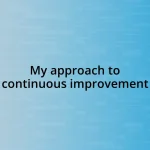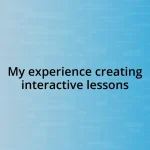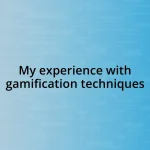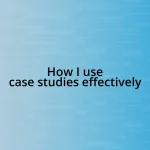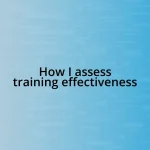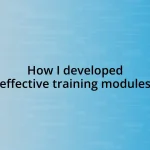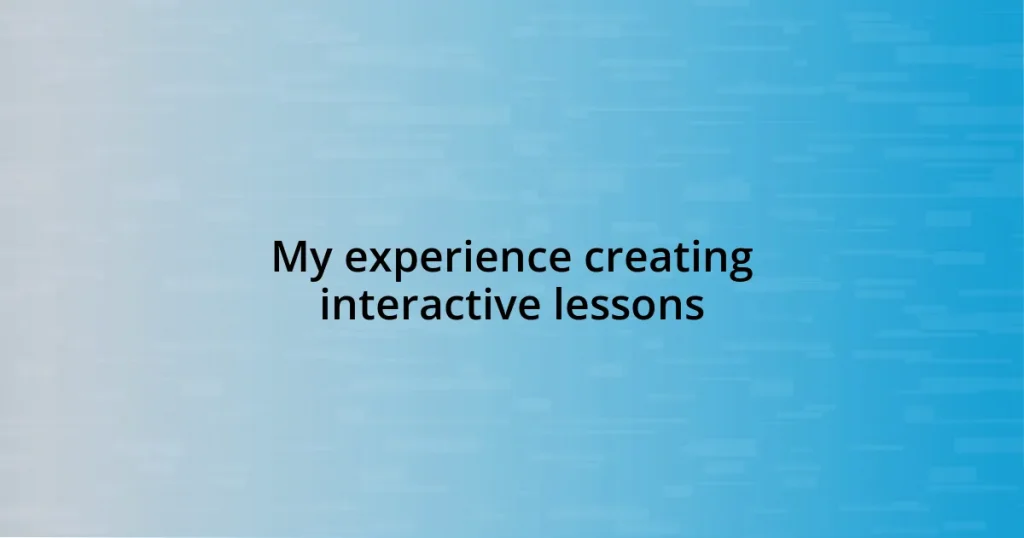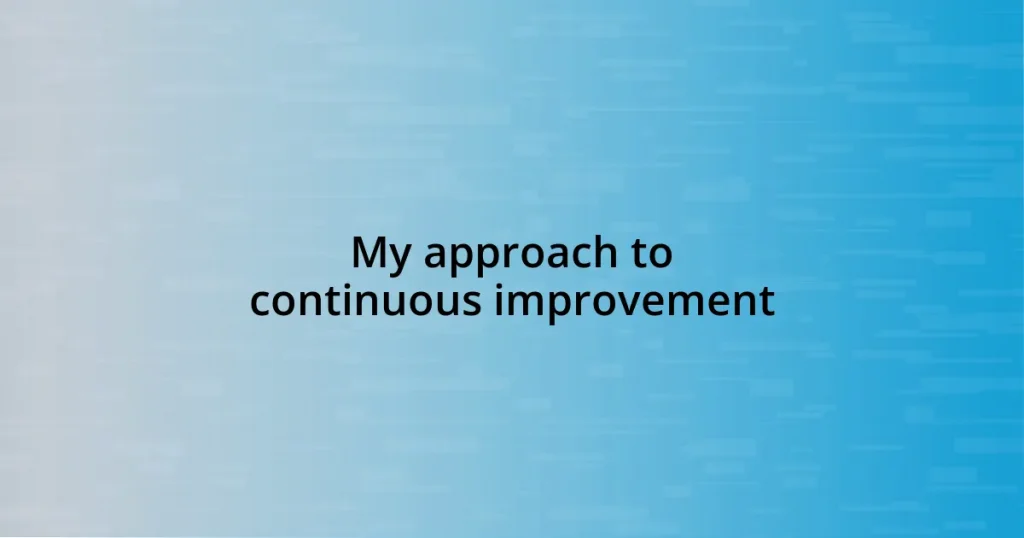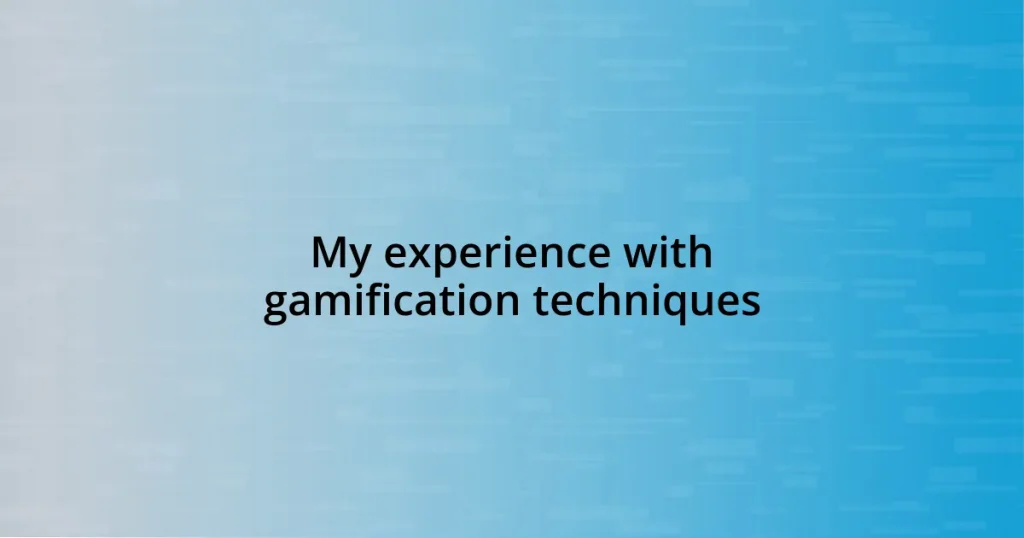Key takeaways:
- Interactive lessons enhance student engagement through group activities and real-world applications, promoting active participation over passive learning.
- Technology tools, like Kahoot! and Socrative, facilitate interactive assignments and instant feedback, fostering a dynamic classroom environment.
- Clear lesson objectives and varying presentation methods encourage ownership of learning, catering to diverse student strengths and learning styles.
- Reflection on teaching practices, including vulnerability and adaptation to student feedback, is crucial for continuous improvement and fostering a supportive learning atmosphere.
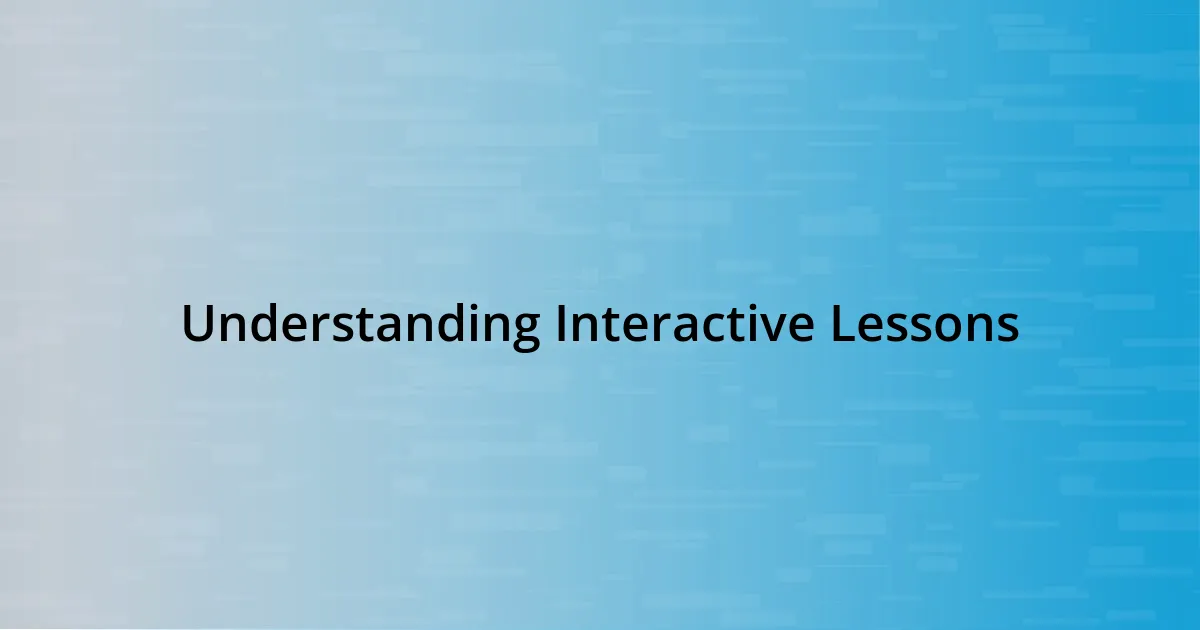
Understanding Interactive Lessons
Interactive lessons transform traditional teaching into engaging experiences. I remember the first time I incorporated group activities in my classroom; the energy was palpable. Students were not just passive listeners; they were active participants, sharing ideas and learning from one another. Isn’t it amazing how collaboration can spark creativity and foster a deeper understanding of the material?
When I think about interactive lessons, I often reflect on the role of technology as a powerful ally. Using tools like interactive quizzes and digital platforms, I’ve seen students come alive, eagerly diving into discussions and problem-solving tasks. Have you ever witnessed the lightbulb moment when a student grasps a concept through hands-on engagement? That moment is what keeps me motivated as an educator.
I find that incorporating real-world scenarios in lessons captivates students’ interest like nothing else. For instance, I once designed a project where students simulated running a small business. They were tasked with budgeting, marketing, and even analyzing sales data. Watching their excitement as they applied classroom knowledge to real-life situations felt incredibly rewarding. Doesn’t it make you think about the potential of interactive lessons to make learning not just educational, but truly impactful?
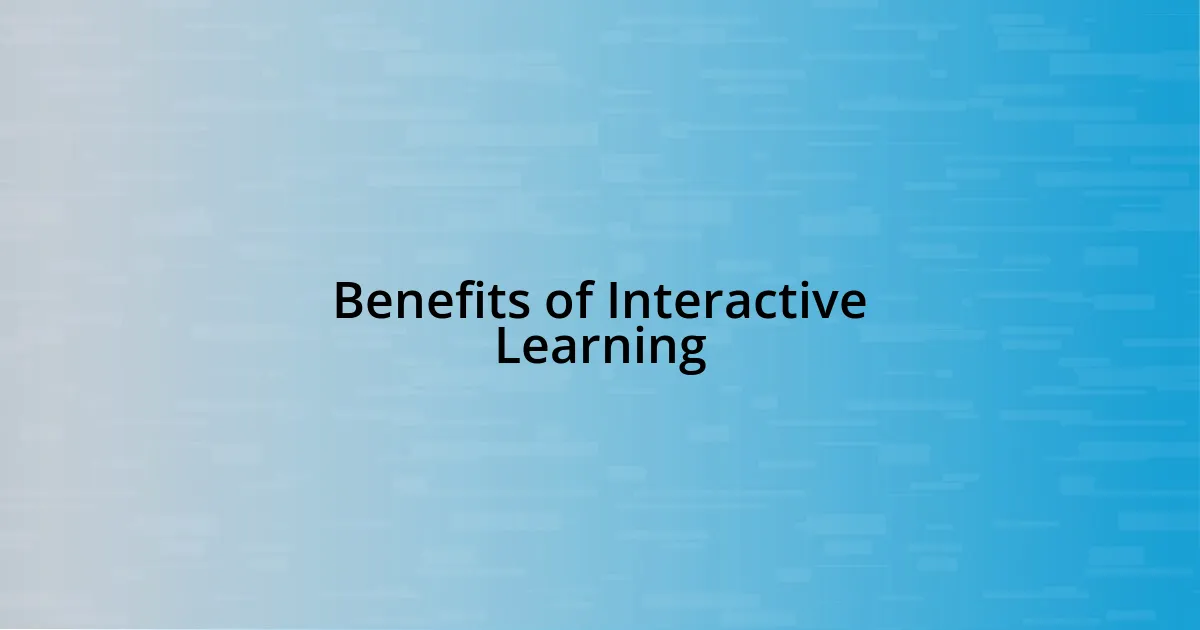
Benefits of Interactive Learning
When I think about the benefits of interactive learning, the first thing that comes to mind is increased student engagement. In one of my classes, I introduced an interactive storytelling exercise where students created their narratives using prompts. The buzz in the room was absolutely electrifying! The students were fully immersed, and their enthusiasm was contagious. It was a vivid reminder of how active participation naturally draws students in, making learning a lively adventure rather than a chore.
Another significant advantage I’ve experienced is the promotion of critical thinking skills. By facilitating debates on complex topics, I noticed that students began questioning and analyzing information more deeply. I can still recall a heated discussion on environmental issues, where students passionately presented various viewpoints. It was fascinating to see them not only defend their opinions but also constructively challenge each other’s arguments. This experience reinforced my belief that when students actively engage with material, they cultivate essential skills that prepare them for the real world.
Moreover, interactive learning fosters collaboration among students. I distinctly remember organizing a group project that required teams to solve a community problem. Watching them brainstorm, negotiate, and ultimately present their solutions as a cohesive unit gave me immense joy. I could see them developing communication skills and building teamwork — crucial traits in today’s world. Isn’t it rewarding to see students grow in such profound ways, just by embracing interactive learning?
| Benefits of Interactive Learning | Examples from My Experience |
|---|---|
| Engagement | Electrifying storytelling exercises that captivated students. |
| Critical Thinking | Debates that encouraged students to analyze and question information. |
| Collaboration | Group projects that developed teamwork and communication skills. |
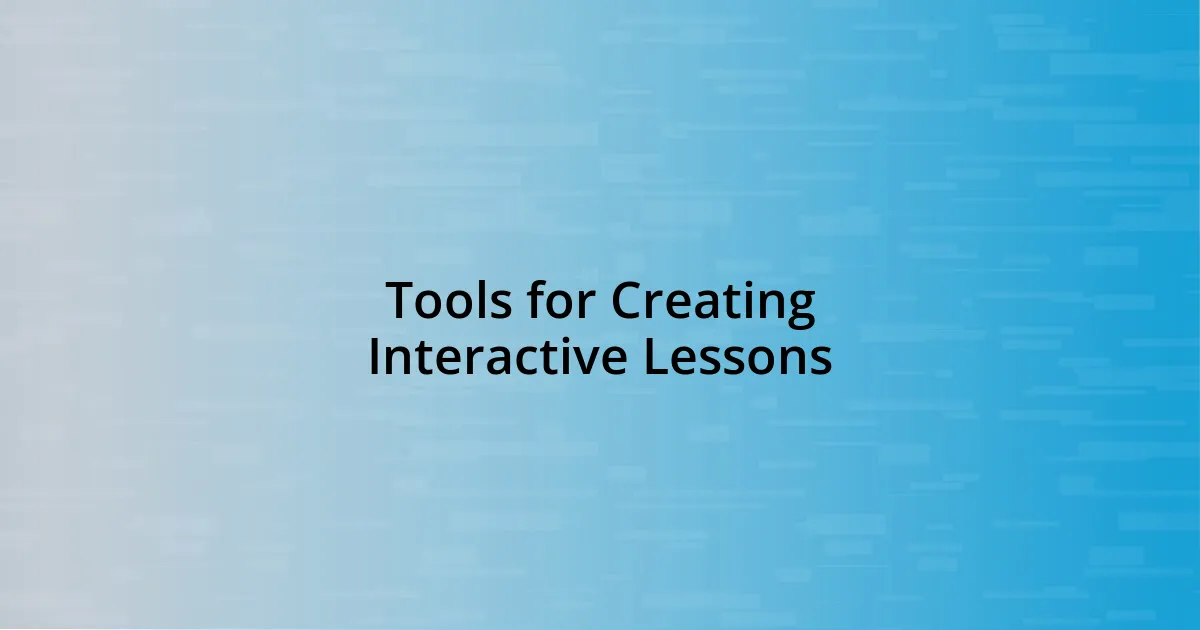
Tools for Creating Interactive Lessons
Creating interactive lessons has been greatly facilitated by a variety of technological tools that I’ve come to rely on in my teaching practice. For instance, I’ve found platforms like Google Classroom to be invaluable. Not only does it allow me to distribute materials easily, but it also enables me to create interactive assignments that promote student engagement. I remember how excited my students were when we used Kahoot! for quizzes; their competitive spirit ignited a thrilling atmosphere in the classroom.
Here’s a quick list of some tools I’ve successfully integrated into my lessons:
- Kahoot!: A game-based learning platform that makes quizzes fun and interactive.
- Socrative: This tool allows real-time assessment with personalized feedback.
- Edpuzzle: Turn videos into engaging lessons by adding questions and notes.
- Flipgrid: Encourages students to discuss and share their opinions through video responses.
- Nearpod: Combines interactive presentations with formative assessments seamlessly.
Each of these tools enriches the learning experience in different ways and fosters an environment where students feel more connected and involved in their education. It’s amazing to witness the transformation in students when they can interact with the material actively rather than passively absorbing information.
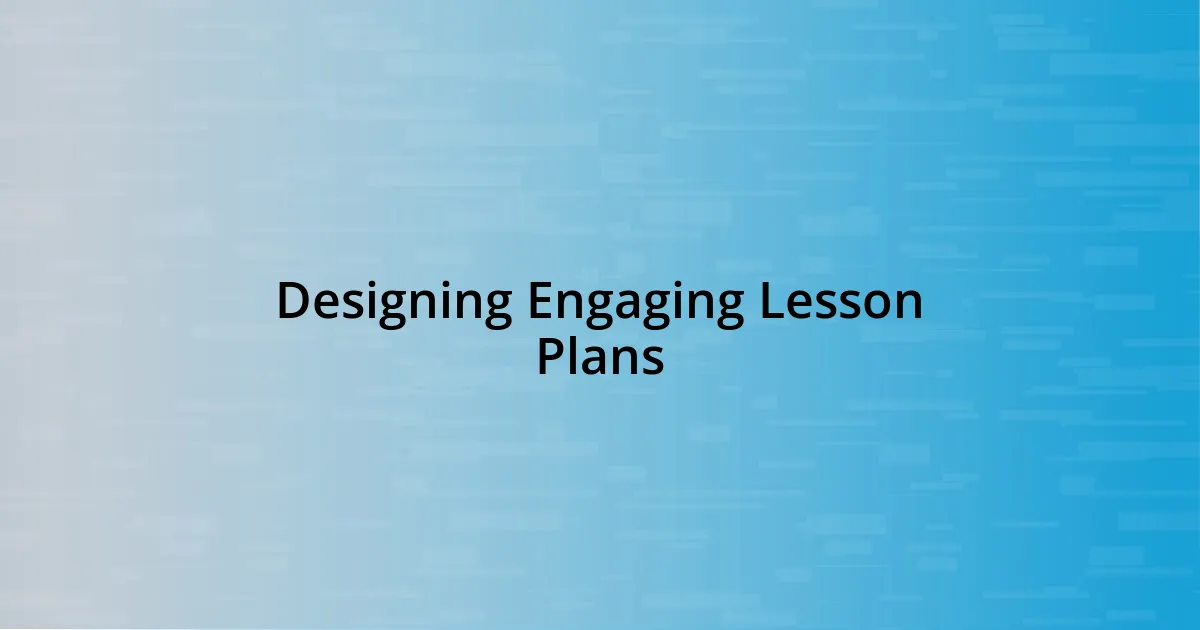
Designing Engaging Lesson Plans
Designing lesson plans that genuinely engage students requires a thoughtful balance of structure and creativity. I remember an instance when I mixed traditional teaching methods with games and discussions. One memorable lesson involved transforming a dull lecture on historical events into a lively scavenger hunt across the classroom. The students weren’t just passive listeners; they were actively seeking information, piecing together clues. How amazing is it to see students connecting the dots while having fun?
In my experience, incorporating different learning styles into lesson plans played a crucial role in engaging all students. I often reflect on a project where students could choose how they wanted to present their research—through art, a presentation, or even a skit. This choice not only sparked their creativity but also allowed them to take ownership of their learning. Seeing a quiet student shine during their artistic presentation reminded me that every student has unique strengths that can enrich the learning environment.
Lastly, I’ve found that setting clear objectives for each lesson makes a huge difference in student engagement. When I outline learning goals at the beginning, students understand the purpose behind the activities. For instance, during a lesson on poetry, I set a goal for students to express their thoughts on emotions creatively. Watching them craft their poems while sharing laughter and deep insights felt exhilarating. Isn’t it inspiring to witness students not only achieve but exceed their learning goals?
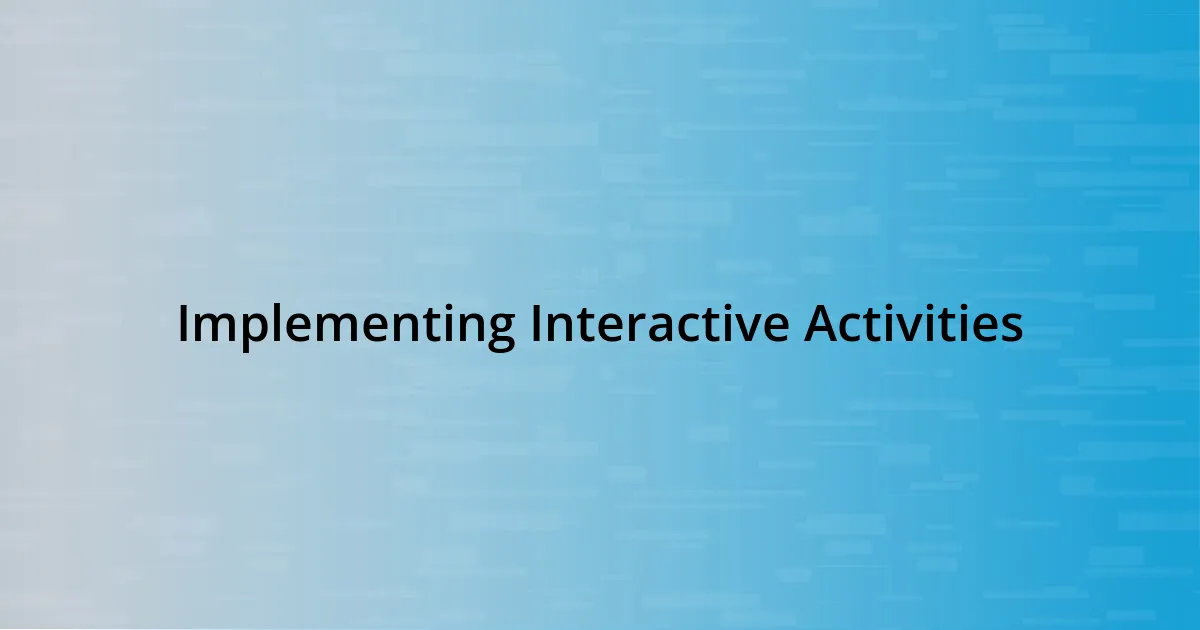
Implementing Interactive Activities
When implementing interactive activities, I’ve discovered that small group work can spark dynamic discussions. For example, during a literature unit, I divided students into pairs to analyze different characters from a play. It was rewarding to watch them engage in thoughtful debates, each student bringing their unique perspectives to the table. I often ask myself, how can I foster that level of engagement consistently?
Another technique I’ve found impactful is incorporating technology that allows for instant feedback. During a math lesson, I used Socrative to give a quick quiz. The moment students received their results, they became genuinely invested in discussing their answers, creating an environment where mistakes became learning opportunities. Isn’t it fascinating how technology can turn anxiety about grades into a constructive dialogue?
Lastly, providing choices in how students demonstrate their knowledge has become a game changer for me. I offered an option for students to create a digital story or a poster project for their final assessment. The enthusiasm was palpable! One student who typically struggled to articulate their ideas excelled with the digital format, surprising everyone—including themselves. Isn’t it incredible how often we underestimate student creativity?
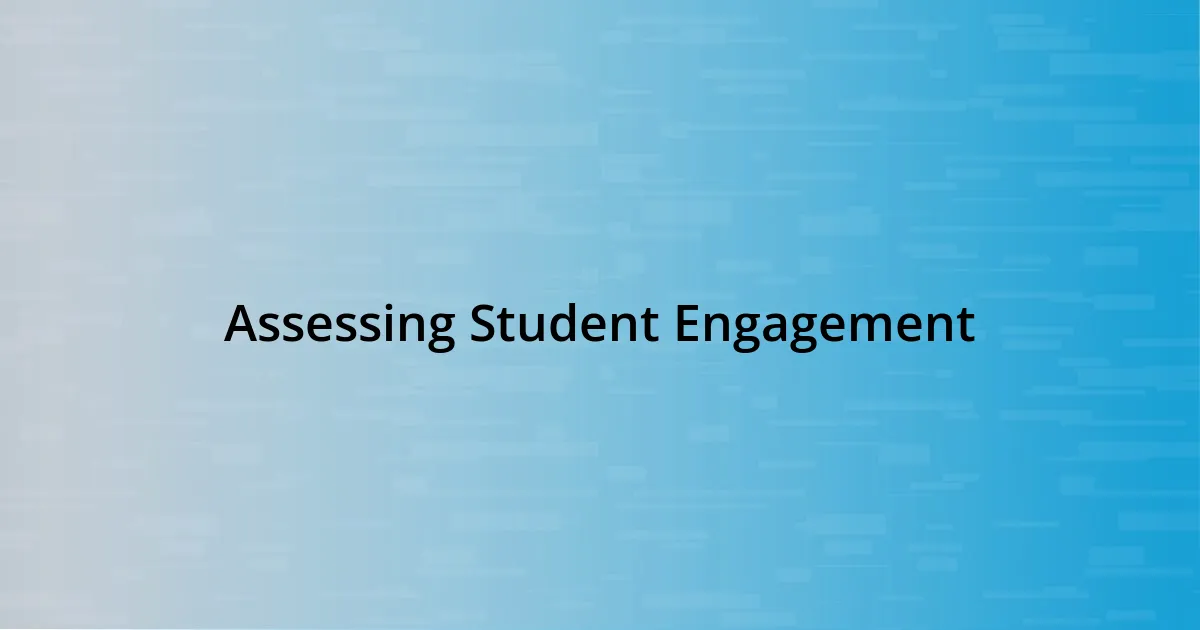
Assessing Student Engagement
Assessing student engagement can feel like piecing together a puzzle. What I’ve learned is that observing body language tells a potent story. I once stood at the back of the room during a project presentation and noted how students leaned in, their eyes wide, fully immersed in their peers’ work. Seeing that level of interest made me realize the importance of not just asking for feedback but truly watching their reactions. Isn’t it rewarding to see the spark in their eyes?
In my journey, I’ve also found that utilizing quick reflective prompts after a lesson sheds light on engagement levels. I remember using a simple exit ticket method where students answered one question: “What was the most exciting part of today’s lesson?” The range of responses provided invaluable insight into what resonated with them and what fell flat. It felt like peeking into their minds, gaining clarity on their engagement. Plus, it opened up an honest dialogue about what they enjoyed and how I could guide future lessons—how cool is that?
Another approach I’ve enjoyed is informal check-ins during class. I often pause midway through a lesson and ask the students to give me a thumbs up if they’re following along, a sideways thumb for unsure, and a down thumb if they’re lost. One day, I noticed a flurry of down thumbs during a tricky concept. It was a wake-up call! This instant feedback enabled me to pivot and provide clarity on the spot. Isn’t it comforting to know we can adjust our teaching in real-time, responding directly to our students’ needs?
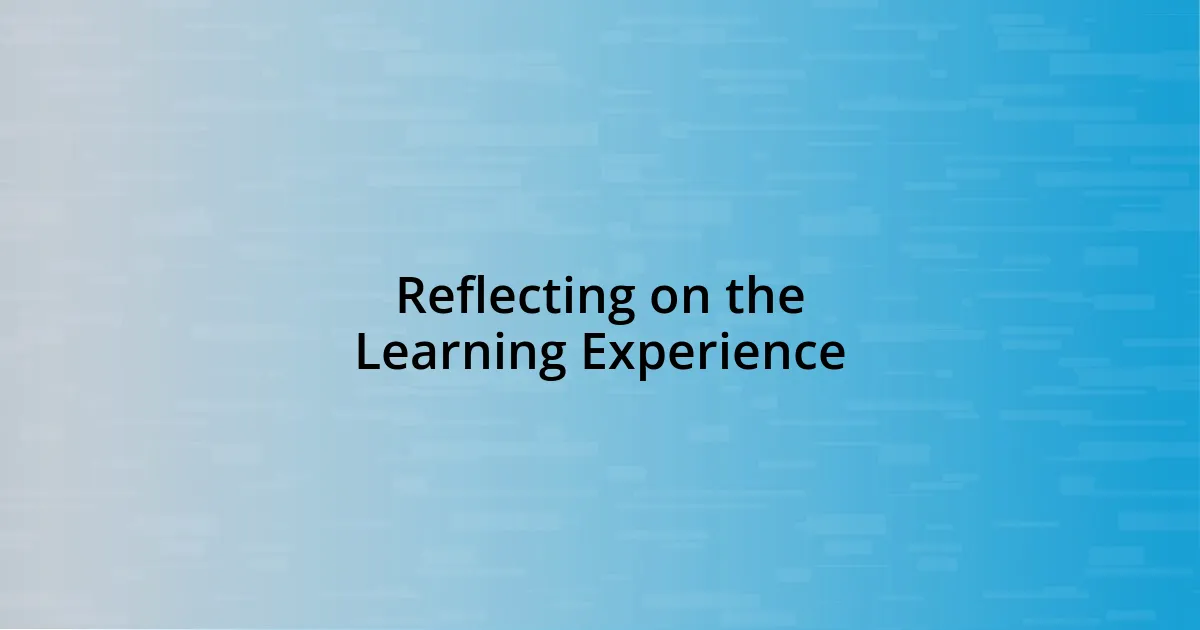
Reflecting on the Learning Experience
Reflecting on the learning experience often leads me to think about the moments that didn’t go as planned. I can remember a lesson where I introduced a new concept, and instead of the usual lively discussions, the room fell eerily silent. It was a stark reminder that engagement isn’t a given—it’s something I must actively cultivate. What if I had invited more open-ended questions to ignite curiosity? That missed opportunity has profoundly shaped the way I approach future lessons.
During my reflections, I’ve also found that sharing my own learning experiences creates a unique bond with my students. There’s something incredibly powerful about admitting when I struggle with a topic or concept. Just last month, I explained math in a way that was clear to me but confounded the class. After that, I shared my own frustration about grasping new mathematical ideas in school. The honesty made them feel safe to express their own struggles, and it transformed the atmosphere—suddenly, we were a team navigating the murky waters of learning together. Isn’t it interesting how vulnerability can strengthen connection in the classroom?
I often ponder how these reflections influence my teaching philosophy. One day, as I sat down to grade projects, I noticed a pattern—many students were hesitant to show their creativity. It struck me deeply; they were operating under a fear of failure rather than embracing the learning journey. This realization pushed me to incorporate more uplifting, positive reinforcement into my feedback. How can we foster a climate where mistakes are seen as stepping stones? Understanding this has driven me to evolve my practices, ensuring that every lesson feels safe and encouraging, inviting students to take risks without the weight of judgment.

